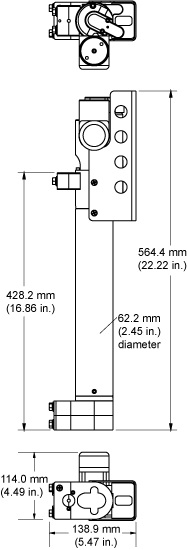 MicroCAT C-T-DO (P optional)
Recorder
MicroCAT C-T-DO (P optional)
RecorderSBE 37-IMP-IDO (Inductive Modem, integral Pump, & Integrated Dissolved Oxygen)
 MicroCAT C-T-DO (P optional)
Recorder
MicroCAT C-T-DO (P optional)
Recorder![]()
![]() Print version
Current manual
(older
manuals)
Reference Sheet
Configuration options & accessories
Print version
Current manual
(older
manuals)
Reference Sheet
Configuration options & accessories
|
Intended
for deployment in orientation shown (sensor end up) for proper operation. |
SUMMARY
DESCRIPTION
The SBE 37-IMP-IDO MicroCAT is a high-accuracy conductivity and temperature (pressure optional) recorder with internal batteries, memory, built-in Inductive Modem, integral Pump, and Integrated Dissolved Oxygen sensor. Constructed of titanium and other non-corroding materials for long life with minimal maintenance, the MicroCAT is designed for long duration on moorings. Calibration coefficients are stored in EEPROM, allowing output of C, T, P, DO, and time in ASCII engineering units (decimal or XML; raw output available).
The Inductive Modem (IM) system provides reliable, low-cost, real-time data transmission for up to 100 IM-enabled instruments using plastic-coated wire rope (typically 3 x 19 galvanized steel) as both the transmission line and mooring tension member. IM instruments clamp anywhere along the rugged mooring wire. Expensive and potentially unreliable multi-conductor electrical cables with fixed position underwater connectors are not required. IM moorings are easily reconfigured (positions changed or instruments added or removed), by sliding and re-clamping sensors on the cable. IM systems are much less expensive and more power-efficient than acoustic modems, and offer reliable communication over greater distances.
In a typical mooring, an Inductive Modem Module (IMM) or Surface Inductive Modem (SIM) housed in the buoy communicates with underwater IM instruments and is interfaced to a computer or data logger via an RS-232 serial port. The computer or data logger (not supplied by Sea-Bird) is programmed to poll each IM instrument on the mooring for its data, and send the data to a telemetry transmitter (satellite link, cell phone, RF modem, etc.). The MicroCAT saves data in memory for upload after recovery, providing a data backup if real-time telemetry is interrupted.
SENSORS
Temperature and Conductivity sensors are based on our field-proven SeaCAT and SeaCATplus. Electrical isolation of conductivity electronics eliminates any possibility of ground-loop noise. Our unique internal-field conductivity cell permits the use of expendable anti-foulant devices, for long-term bio-fouling protection. The aged and pressure-protected thermistor has a long history of exceptional accuracy and stability. The IDO is a frequency-output version of our field-proven SBE 43 Dissolved Oxygen sensor, with the same performance specifications.
The optional strain-gauge pressure sensor is available in eight ranges, to a maximum depth of 7000 meters. Compensation of the temperature influence on pressure is performed by the MicroCAT’s CPU.
PUMP
The integral pump runs each time the MicroCAT samples, providing the following advantages:
With Adaptive Pump Control, the MicroCAT calculates the pumping time for best oxygen accuracy as a function of the previous sample's temperature and pressure (maximizing data quality while minimizing power consumption).
OPERATING MODES
User-selectable operating modes include:
SOFTWARE
The MicroCAT is supplied with a powerful Windows software package, Seasoft© V2, which includes:
DATA STORAGE AND BATTERY ENDURANCE
Temperature and conductivity are stored 6 bytes/sample, time 4 bytes/sample, oxygen 3 bytes/sample, and optional pressure 5 bytes/sample; memory capacity is in excess of 444,000 samples (with pressure). The MicroCAT is powered by a 7.8 Amp-hour (nominal) battery pack consisting of twelve AA lithium cells (Saft LS14500) which, when removed from the MicroCAT, can be shipped via commercial aircraft. Battery endurance varies widely, depending on the sampling scheme and deployment pressure and temperature. Sampling every 10 minutes in water temperatures of approximately 10 °C, the MicroCAT can be deployed for almost 6 months (24,000 samples); see the manual for example calculations.
SPECIFICATIONS
|
Measurement Range |
Initial Accuracy |
Typical Stability |
Resolution | |
| Conductivity |
0
to 7 S/m (0 to 70 mS/cm) |
± 0.0003 S/m (0.003 mS/cm) |
0.0003 S/m (0.003 mS/cm) per month |
0.00001 S/m (0.0001 mS/cm) |
|
Temperature (°C) |
-5 to 45 |
± 0.002
(-5 to 35 °C); ± 0.01 (35 to 45 °C) |
0.0002 per month | 0.0001 |
| Oxygen |
120% of surface saturation (all natural waters, fresh and salt) |
± 2% of saturation | 0.5% per 1000 hours | 0.035% of saturation |
| Optional Pressure |
20 / 100 / 350 /
600 /
1000 / 2000 / 3500 / 7000 m (meters of deployment depth capability) |
± 0.1% of full scale range | 0.05% of full scale range per year | 0.002% of full scale range |
Clock Stability: 5 sec/month
Power Consumption:
Quiescent: 0.0007 Watts
CTD-DO Sample Acquisition
(excluding pump):
Without pressure 0.10 Watts
With pressure 0.17 Watts
CTD-DO Sample Waiting (not
sampling, pump running, excluding pump):
With pressure 0.016 Watts
Pump: 0.12 Watts
Communications:
IM 0.009 Watts listening, 0.13 Watts
transmitting
RS-232 0.06 Watts
Power Supply: 7.8 Amp-hour (nominal) battery pack, 257 KJoules (derated for calculations)
Housing, Depth Rating, & Weight:
| Housing Material | Depth Rating | Weight (with standard mounting guide and clamp) |
| Plastic | 350 m (1150 ft) | In air: 3.8 kg (8.5 lbs) |
| Titanium | 7000 m (23,000 feet) | In air: 4.5 kg (10.0 lbs) |
Dimensions

ADDITIONAL INFORMATION / LINKS:
Documentation -- manual, photos, technical papers, application notes, etc.
Sales Information -- options, accessories, cables, mount kits, spares, etc.
Software -- components of Seasoft V2
Links to Other Instruments of Interest
![]()
Specifications are subject to change without notice.
Sea-Bird Home Phone: (+1) 425-643-9866 E-mail: seabird@seabird.com